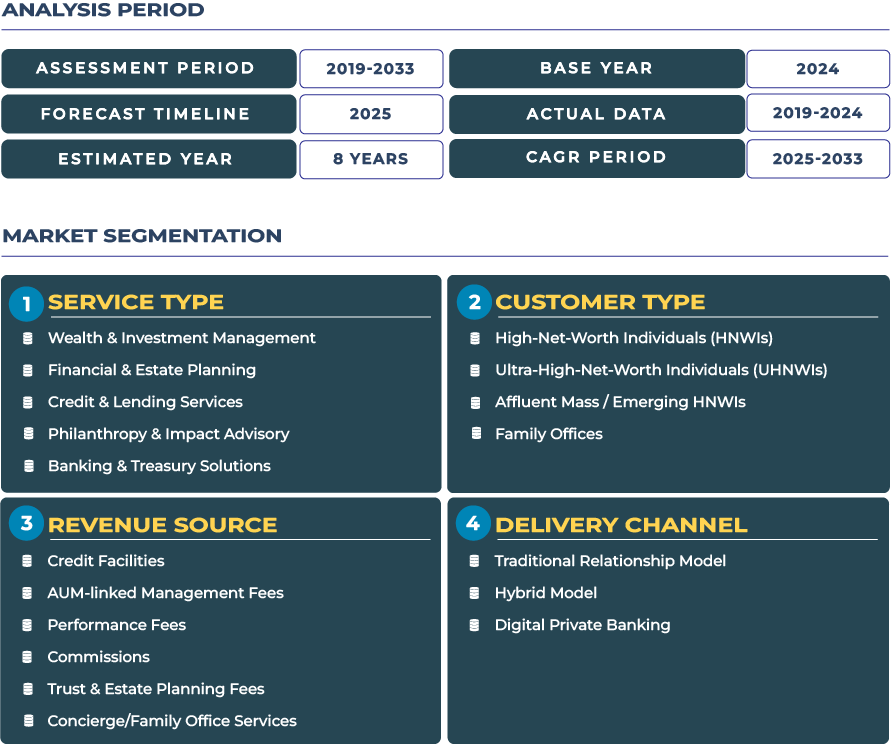Market Outlook: Strategic Growth Roadmap for Eastern Europe’s Private Banking Ecosystem into 2033
The outlook for the Eastern Europe private banking landscape is one of robust growth underpinned by structural momentum rather than mere cyclical lift. Rising from USD 36.4 billion in 2025 to USD 58.1 billion by 2033, the forecasted 6.0% CAGR indicates that investors and wealth managers in the region are increasingly engaging in wealth-creation models-not just capital preservation. Private banking firms active in Eastern Europe will therefore need to position themselves around holistic advisory, wealth structuring, integrated credit solutions and cross-border mobility.
Note:* The market size refers to the total revenue generated by banks through various services.
Key macro-tailwinds include rising business exits among regional entrepreneurs, growing intergenerational wealth, the scaling of alternative-asset access, and the push for digital-wealth engagement. However, this growth path is not without its hurdles. Eastern Europe also contends with geopolitical risk, regulatory fragmentation across jurisdictions, currency instability and a need to upgrade operational platforms in wealth management. In this environment, private banks that embed mobile-first advisory, seamless global treasury/credit engines, and regional wealth hubs will capture disproportionate share of value as the 6.0% CAGR materialises.
Growth Catalysts & Structural Impediments: What Accelerates and What Slows the Eastern Europe Private Banking Sector
Accelerating factors: The private banking market in Eastern Europe is energized by several potent growth drivers. Wealth-diversification needs are increasingly voiced by high-net-worth individuals (HNWIs) in the region, particularly as domestic markets open and global investment access expands. Local fintech growth-especially digital apps for portfolio management, payments and advisory-is enabling private banks to scale services and reduce cost-to-serve. Moreover, regional consolidation of banking and private-wealth platforms across CEE is creating broader service ecosystems for clients who demand global investment services, credit structures and wealth planning.
Hindering factors: Nonetheless, several structural constraints temper growth in the Eastern Europe private banking industry. Political instability-such as the war in Ukraine, sanctions regimes and shifting regulatory regimes-introduces capital-flow uncertainty and risk-premium inflation. Currency volatility remains a concern for HNWIs investing internationally from Eastern Europe, impacting either asset values or hedging costs. Data security, compliance infrastructure and legacy banking models often lag international standards, raising cost-to-serve and limiting service offerings for the affluent segment. Altogether, these factors require private banks to build stronger risk frameworks, invest in compliance and diversify service delivery to drive sustainable growth.
Trend-Vectors & Opportunity Frameworks: Mobile-First Wealth Apps, Fintech-Bank Alliances and Cross-Border UHNW Services in Eastern Europe’s Private Banking Market
Emerging trend-vectors: In Eastern Europe’s private banking landscape, major trends are taking shape. Mobile-first wealth-apps are rapidly supplanting legacy platforms-affluent clients demand real-time on-the-go dashboards, investment access and treasury integration. Offshore diversification is increasingly sought: wealthy clients in Poland, Czechia, Romania and Russia are looking for global allocation and wealth-structuring beyond domestic borders. Regional bank alliances-particularly between local universal banks and global private-banking platforms-are forming to deliver multi-jurisdiction advisory, alternative assets and structured credit to affluent clients.
Opportunity frameworks: Private banks active in Eastern Europe face compelling opportunity windows. Fintech-bank tie-ups help institutions leapfrog technology-investment lag: partnering with local digital-wealth start-ups enables rapid deployment of advisory and payments functionality. Cross-border ultra-HNW services-supporting migration, domicile structuring and family-office advisory-represent a growth agenda that high-net-worth clients in the region are increasingly adopting. Wealth-security platforms-such as encrypted dashboards, international custody, private-market access and legacy-transition advisory-will differentiate firms servicing the ascending affluent segment. Capitalising on these frameworks will enable institutions to capture the 6.0% CAGR and establish leadership in Eastern Europe’s private banking ecosystem.
Regional Country Focus: Snapshot of Key Markets in Eastern Europe Private Banking
Russia: Despite sanctions and capital-flow headwinds, Russia remains a significant source of private banking demand, especially around estate planning, cross-border advisory and alternative-asset allocation. The market is shifting toward global diversification of Russian-based wealth.
Poland: Poland’s private banking market is gaining traction, driven by growing entrepreneurship, asset accumulation and rising affordability of wealth-management services. Polish private banks are expanding credit/lending overlays and investment-advisory depth to retain local affluent clients.
Competitive Landscape: Strategic Realignments in Eastern Europe’s Private Banking Industry
The competitive environment in Eastern Europe’s private banking market is evolving rapidly. A prominent institution, OTP Bank, headquartered in Hungary and operating across CEE, recognised in March 2024 as “CEE’s Best Regional Private Bank” by a leading industry publication. The bank’s success signals the broader trend of regional players stepping up to service HNWIs across multiple Eastern European jurisdictions. Strategies gaining focus include segmenting wealthy clients by domicile and generation; integrating platforms across investment, credit, treasury, and philanthropy; forming partnerships with fintechs to enhance digital-wealth delivery; and implementing cross-border advisory models for clients transitioning or diversifying internationally. Institutions that pivot from simple wealth-preservation services toward proactive wealth-creation platforms are positioned to lead the Eastern Europe private banking market.








